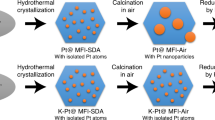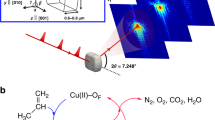Abstract
The aluminosilicate framework of synthetic ‘zeolites’ of type A (Na+-form) and ZSM-5, as well as the Na+-forms of faujasite (Fig. 1) in their so-called X- and Y-variants (fuller structural descriptions are given in ref s 1 and 2) have recently been imaged at near-atomic scale by high-resolution electron microscopy (HREM)3–5. However, the as-prepared synthetic and naturally occurring zeolites, all of which contain alkali metal and alkaline-earth exhangeable cations and much constitutional, intracrys-tallite water, are converted within minutes into an amorphous state on examination in an electron beam of the intensity required to yield high-resolution images. The specimen has to withstand 106 electrons Å−2 bombardment within a few minutes. To extract further information from HREM about the local atomic structure, and, in particular, to identify the siting of the various cations that may be accomodated in these catalytically important and shape-selective materials, methods have to be developed which retain the structural integrity of the zeolite for a reasonable time under electron irradiation in vacuo. It has been shown3 that dehydration of the zeolite before observation significantly increases its lifetime in an electron beam. Here we show that the commercially important4 zeolite-Y may be chemically stabilized against electron irradiation damage by the simple expedient of incorporating uranyl (UO2+2) ions into the structure beforehand. Beam sensitivities are decreased by factors of 10–100 in this way, but appropriate heat-treatment of the UO2-exchanged zeolite is required to achieve this stability and hence to locate these heavy cations.
Similar content being viewed by others
References
Meier, W. M. & Olsen, D. H. Atlas of Zeolite Structure Types (Juris Druck, Zurich, 1978).
Barrer, R. M. Zeolites and Clay Minerals as Sorbents and Molecular Sieves (Academic, London, 1978).
Bursill, L. A., Lodge, E. A. & Thomas, J. M. Nature 286, 111–113 (1980).
Thomas, J. M., Millward, G. R. & Bursill, L. A. Phil. Trans. R. Soc. (in the press).
Thomas, J. M. & Bursill, L. A. Angew. Chem. 92, 755–756 (1980).
Thomas, J. M. New Scient. 87, 580–584 (1980).
Lynch, D. F., Moodie, A. F. & O'Keefe, M. A. Acta crystallogr. A 31, 300 (1975).
Deane, A. M. J. Inorg. nucl. Chem. 21, 238 (1961).
Terada, M. & Tsubri, M. Bull chem. Soc. Jap. 37, 1080 (1964).
Author information
Authors and Affiliations
Rights and permissions
About this article
Cite this article
Bursill, L., Thomas, J. & Rao, K. Stability of zeolites under electron irradiation and imaging of heavy cations in silicates. Nature 289, 157–158 (1981). https://doi.org/10.1038/289157a0
Received:
Accepted:
Issue Date:
DOI: https://doi.org/10.1038/289157a0
- Springer Nature Limited
This article is cited by
-
One-dimensional intergrowths in two-dimensional zeolite nanosheets and their effect on ultra-selective transport
Nature Materials (2020)
-
Direct imaging of single metal atoms and clusters in the pores of dealuminated HY zeolite
Nature Nanotechnology (2010)
-
Computer simulation studies of Ar clusters
Bulletin of Materials Science (1999)
-
Fixation of actinide elements into zeolites/zeotypes and Flexcrete-cement matrix
Journal of Radioanalytical and Nuclear Chemistry Articles (1993)





